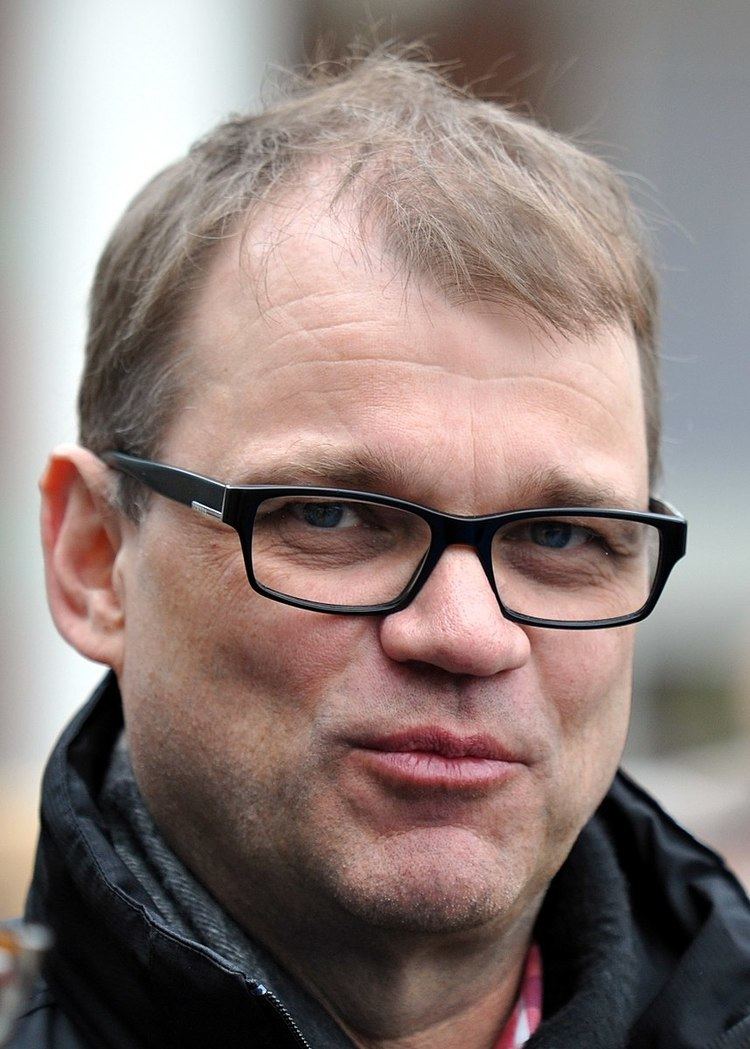Style Excellency Formation 27 November 1917 | Residence Kesäranta | |
 | ||
Member of Cabinet
European Council Appointer The President of the Republic Term length No fixed term
Duration of parliamentary convocation, coalition or upon resignation and removal | ||
The Prime Minister (Finnish: pääministeri, literally translated as Head Minister, Swedish: statsminister, literally translated as Minister of State) is the Head of Government of Finland. The Prime Minister is appointed by the President, who is the Head of State. The current Prime Minister is Juha Sipilä of the Centre Party.
Contents
Overview
Under the provisions of the new Constitution of Finland (enacted in 2000), the President nominates a Prime Minister after the parties in the Eduskunta/Riksdag (Parliament) have negotiated the distribution of seats in the new Council of State and the government's programme. Parliament must ratify the nominated Prime Minister with an absolute majority in a vote without other candidates. If the nominee doesn't receive sufficient support, then a new round of negotiations and a second nomination by the President follows. If the second nominee also fails to gain an absolute majority, then a third vote occurs, in which any member of Parliament can nominate a candidate; in this round a plurality is sufficient for election. The President's formal appointment follows Parliament's election.
The above procedure was first used to elect Anneli Jäätteenmäki to the premiership in 2003. Previously it was assumed that the President would nominate the candidate who in a third round of voting would have gained a relative majority, usually the leader of the largest party. Before the new Constitution came into force, full formal powers to appoint the Prime Minister and the rest of the Council of State had been the privilege of the President, who was free to diverge from parliamentary principles, although ministers appointed had to have the confidence of the Parliament.
Formally, the Prime Minister nominates the remaining members of the Council of State, who are then, with the consent of Parliament, appointed by the President. In practice, the seats are divided between parties during the negotiations to form the government, so that the Prime Minister candidate must take into account the opinions of the participating parties and cannot nominate or remove whoever he wishes.
Although the Prime Minister is one of the nation's leading political figures, he is not as powerful as his or her counterparts in the rest of northern Europe. This is mainly because no one party has a realistic chance of winning an outright majority, and it is very difficult for the socialists and non-socialist blocs to form a coalition on their own. A Prime Minister usually leads a grand coalition of three or more parties. The Cabinet follows a government platform agreed upon by the participating parties.
History
In 1918, the Finnish Senate was transformed into the Council of State (or cabinet) of Finland, and the position of Vice-Chairman of the Economic Division of the Senate was transformed into that of a Prime Minister. Kesäranta (in Swedish Villa Bjälbo), located in the Meilahti area of Helsinki, has been the official residence of the Prime Minister of Finland since 1919.
Since its independence (declared on 6 December 1917), Finland has had 71 cabinets, including the current one, the longest lasting being the two cabinets of Prime Minister Paavo Lipponen, both lasting 1,464 days.
Salary and other benefits
The salary of the prime minister is by law the same as the salary of the Speaker of the Parliament, which is €11,675 a month (from 1 May 2011). In addition, the prime minister receives a half of the parliamentary salary to which he or she is entitled as a sitting member of Parliament. The full parliamentary salary is currently (as of 1 May 2011) at least €6,335 a month, so the Finnish prime minister receives at least €14,842 per month in total. The salary is subject to normal income tax.
The prime minister is entitled to a 30-day leave (holiday) during each calendar year. The maintenance, staff and services of the official residence (Kesäranta) is paid for by the government.
The prime minister has transportation and security services at their disposal at all times.
